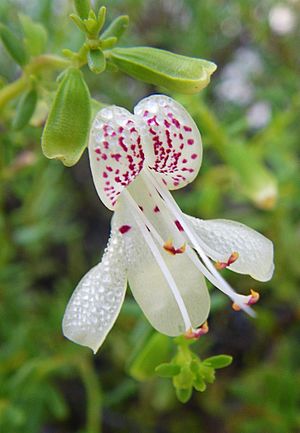Garrett's mint facts for kids
Quick facts for kids Garrett's mint |
|
|---|---|
 |
|
| Conservation status | |
| Scientific classification | |
| Genus: |
Dicerandra
|
| Species: |
christmanii
|
Dicerandra christmanii is a very special and rare flowering plant. It's also known as Garrett's mint, yellow scrub balm, or Lake Wales balm. This plant is part of the mint family. It grows only in one small area in Highlands County, Florida, in the United States. This area is called the Lake Wales Ridge.
Garrett's mint is found in only four spots. These spots are all within a small area, about 6 by 3 kilometers. Sadly, this plant is becoming rarer. Its home is being destroyed or changed. Only one of the four places where it grows is protected. Because it is so rare and in danger, it is listed as a federally endangered species.
Contents
About Garrett's Mint
What Does It Look Like?
Garrett's mint is a small, fragrant shrub. It can grow up to about 1.3 feet (40 centimeters) tall. Its stems are square-shaped and have ridges. The leaves grow in pairs on opposite sides of the stem. Both the stems and leaves have many tiny oil glands. These glands give the plant its special smell.
This plant blooms in the summer and fall. Its flowers are white or cream-colored. They often have purple spots on their petals. The flowers can grow alone or in groups of three. Inside the flower, you'll see yellow parts called anthers. These anthers stick out from the flower's opening. They hold white pollen. The anthers have small spurs. These spurs help release the pollen when an insect visits.
How Is It Different from Other Mints?
Garrett's mint was first found in 1948 by Ray Garrett. For a while, people thought it was the same as a similar plant, Dicerandra frutescens. But in 1989, scientists looked at it more closely. They found that Garrett's mint was a new species.
They noticed a few key differences:
- Garrett's mint has white or cream-colored flowers with yellow anthers.
- It has a fresh, menthol-like scent.
- Its leaves are shorter.
In contrast, D. frutescens has cream flowers that turn white. Its anthers are purple or white. Other than these differences, the two plants look quite similar.
Where Does It Live?
Garrett's mint is one of many special plants found only on the Lake Wales Ridge. This area is known for having many unique plants and animals that live nowhere else. The plant's home is a type of forest called yellow-sand Florida scrub.
This scrub habitat has:
- Sand pines (Pinus clausa)
- Different kinds of oak trees
- Scrub hickory (Carya floridana)
Garrett's mint does not grow in the same exact spots as D. frutescens. It prefers areas slightly north of its relative.
Why Is Its Home Special?
The Florida scrub habitat needs natural wildfires to stay healthy. Fires help clear out old plants and leaf litter on the ground. This creates open spaces where plants like Garrett's mint can grow. Without fire, larger plants can grow too tall and block the sunlight. This makes it hard for the mint to survive. Plants in open areas also get visited more by pollinators.
The main pollinator for Garrett's mint is a type of bee-fly called Exprosopa fasciata. This bee-fly helps the plant make seeds.
Why Is It in Danger?
Garrett's mint is in serious trouble. Its habitat is shrinking and changing.
- Habitat Loss: Many areas where it used to grow have been turned into citrus groves (farms for oranges and other citrus fruits). This breaks up its natural home into smaller pieces.
- Lack of Fire: People have stopped natural fires from happening. This means the scrub habitat gets overgrown. The mint needs open, sunny spots to grow.
- Drought: Long periods without rain can harm the plants.
- Invasive Plants: A harmful plant called cogon grass (Imperata cylindrica) is spreading. It takes over space and resources that Garrett's mint needs.
- Limited Seed Spread: The plant's seeds don't travel very far. With its habitat broken up, it's even harder for new plants to grow in new places.
- Human Activities: Things like off-road vehicles driving through its habitat and trash dumping can also damage the area.
Because its close relative, D. frutescens, was already endangered, Garrett's mint was also given this status when it was identified as a separate species. It is considered one of the most critically endangered plants on the Lake Wales Ridge.


